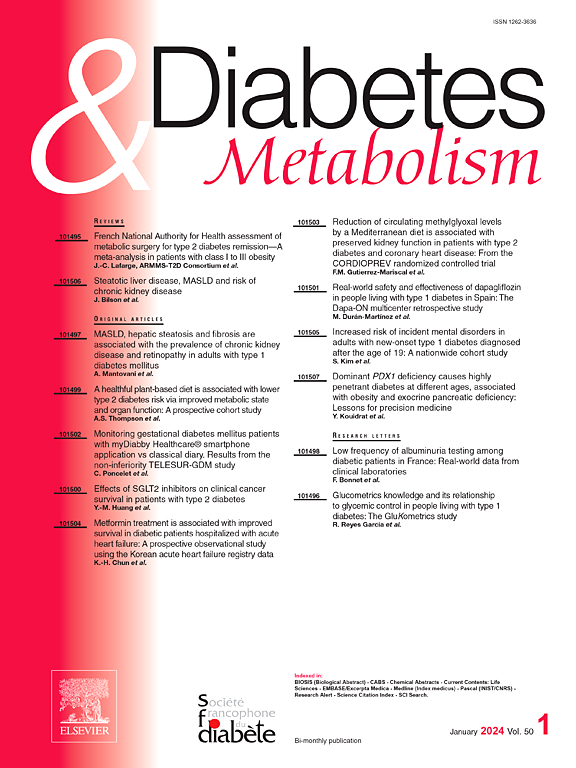一级亲属 1-2 期临床前期 1 型糖尿病的筛查和护理:法国专家立场声明。
IF 4.7
2区 医学
Q1 ENDOCRINOLOGY & METABOLISM
引用次数: 0
摘要
1 型糖尿病(T1D)的自然病史从 1 期(胰岛自身免疫,血糖正常;ICD-10 诊断代码 E10.A1)发展到 2 期(自身免疫,血糖异常;E10.A2)和随后的临床 3 期(明显的高血糖),这通常是首次转诊。自身抗体检测可以在 T1D 的临床前 1-2 期诊断出 T1D,从而更早地开始治疗,尤其是对于 T1D 患者的一级亲属,因为他们的遗传风险更高。临床前期 T1D 筛查和监测的目的是避免就诊时发生酮症酸中毒,延长内源性胰岛素分泌的保存时间,从而改善血糖控制,降低长期发病率。此外,早期管理有助于应对 T1D 和纠正可改变的风险因素(肥胖、久坐不动的生活方式)。目前正在临床应用或试验中的新疗法也为延缓临床进展提供了可能。所有这些论点都促使我们提出了一项面向感兴趣的一级亲属的全国性筛查和治疗方案。该路径是医疗保健专业人员需要掌握的一项新的专业知识。根据法国的具体情况调整国际共识指南,建议的筛查策略包括对 2-45 岁的亲属进行≥ 2 种自身抗体(IAA、抗-GAD、抗-IA-2)检测。阴性筛查(95% 的病例)应每 4 年重复一次,直至 12 岁。针对筛查呈阳性的亲属(占病例的 5%),提出了一套管理工作流程,根据 T1D 阶段、年龄、患者偏好和可用资源以及临床前 T1D 专家中心的定义,通过自身抗体检测、OGTT、血糖和/或 HbA1c 进行不同频率的免疫代谢监测。本文章由计算机程序翻译,如有差异,请以英文原文为准。
Screening and care for preclinical stage 1–2 type 1 diabetes in first-degree relatives: French expert position statement
The natural history of type 1 diabetes (T1D) evolves from stage 1 (islet autoimmunity with normoglycemia; ICD-10 diagnostic code E10.A1) to stage 2 (autoimmunity with dysglycemia; E10.A2) and subsequent clinical stage 3 (overt hyperglycemia), which is commonly the first time of referral. Autoantibody testing can diagnose T1D at its preclinical stages 1–2 and lead to earlier initiation of care, particularly for first-degree relatives of people living with T1D, who are at higher genetic risk. Preclinical T1D screening and monitoring aims to avoid inaugural ketoacidosis and prolong preservation of endogenous insulin secretion, thereby improving glycemic control and reducing long-term morbidity. Moreover, early management can help coping with T1D and correct modifiable risk factors (obesity, sedentary lifestyle). New treatments currently under clinical deployment or trials also offer the possibility of delaying clinical progression. All these arguments lead to the proposition of a national screening and care pathway open to interested first-degree relatives. This pathway represents a new expertise to acquire for healthcare professionals. By adapting international consensus guidance to the French specificities, the proposed screening strategy involves testing for ≥ 2 autoantibodies (among IAA, anti-GAD, anti-IA-2) in relatives aged 2–45 years. Negative screening (∼95 % of cases) should be repeated every 4 years until the age of 12. A management workflow is proposed for relatives screening positive (∼5 % of cases), with immuno-metabolic monitoring by autoantibody testing, OGTT, glycemia and/or HbA1c of variable frequency, depending on T1D stage, age, patient preference and available resources, as well as the definition of expert centers for preclinical T1D.
求助全文
通过发布文献求助,成功后即可免费获取论文全文。
去求助
来源期刊

Diabetes & metabolism
医学-内分泌学与代谢
CiteScore
12.00
自引率
4.20%
发文量
86
审稿时长
13 days
期刊介绍:
A high quality scientific journal with an international readership
Official publication of the SFD, Diabetes & Metabolism, publishes high-quality papers by leading teams, forming a close link between hospital and research units. Diabetes & Metabolism is published in English language and is indexed in all major databases with its impact factor constantly progressing.
Diabetes & Metabolism contains original articles, short reports and comprehensive reviews.
 求助内容:
求助内容: 应助结果提醒方式:
应助结果提醒方式:


